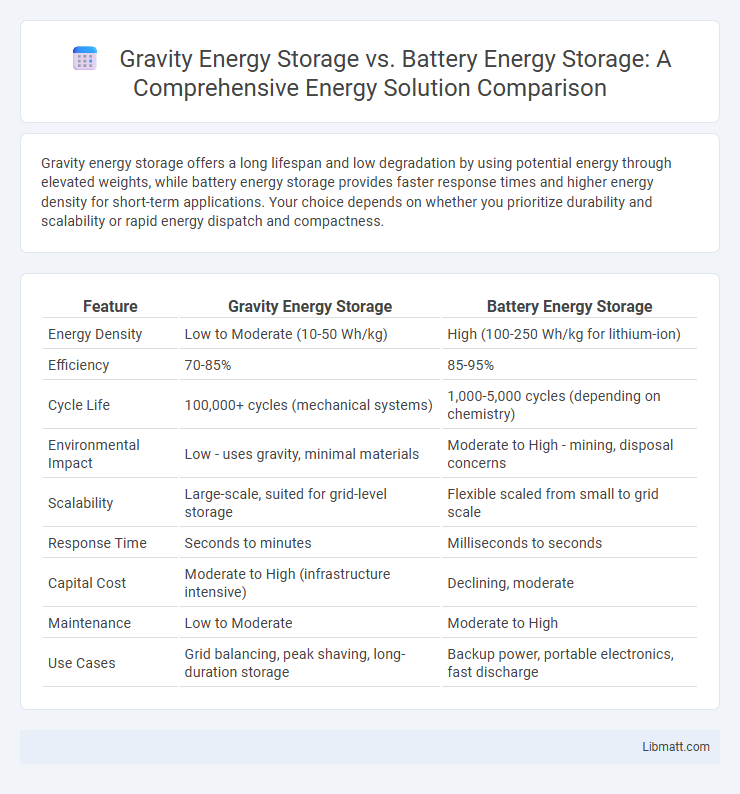Gravity energy storage offers a long lifespan and low degradation by using potential energy through elevated weights, while battery energy storage provides faster response times and higher energy density for short-term applications. Your choice depends on whether you prioritize durability and scalability or rapid energy dispatch and compactness.
Table of Comparison
| Feature | Gravity Energy Storage | Battery Energy Storage |
|---|---|---|
| Energy Density | Low to Moderate (10-50 Wh/kg) | High (100-250 Wh/kg for lithium-ion) |
| Efficiency | 70-85% | 85-95% |
| Cycle Life | 100,000+ cycles (mechanical systems) | 1,000-5,000 cycles (depending on chemistry) |
| Environmental Impact | Low - uses gravity, minimal materials | Moderate to High - mining, disposal concerns |
| Scalability | Large-scale, suited for grid-level storage | Flexible scaled from small to grid scale |
| Response Time | Seconds to minutes | Milliseconds to seconds |
| Capital Cost | Moderate to High (infrastructure intensive) | Declining, moderate |
| Maintenance | Low to Moderate | Moderate to High |
| Use Cases | Grid balancing, peak shaving, long-duration storage | Backup power, portable electronics, fast discharge |
Introduction to Gravity and Battery Energy Storage
Gravity energy storage utilizes potential energy by lifting heavy weights, releasing power as they descend, offering long-duration storage with minimal degradation. Battery energy storage relies on electrochemical cells, converting chemical energy to electricity for rapid, high-efficiency discharge and flexibility in diverse applications. Understanding these foundational technologies helps you choose the best energy storage solution for your specific needs and sustainability goals.
How Gravity Energy Storage Works
Gravity energy storage operates by lifting a heavy mass using excess electricity and then releasing it to generate power as the mass descends, converting potential energy into electrical energy through generators. This method leverages gravitational force without chemical reactions or degradation, ensuring high durability and long lifespan compared to battery energy storage systems. Efficiency in gravity energy storage depends on factors like mass, height of elevation, and system design, making it a sustainable alternative for grid-scale energy storage.
How Battery Energy Storage Works
Battery energy storage functions by converting electrical energy into chemical energy during charging, storing it within electrochemical cells. When discharging, the chemical reactions reverse, releasing electrical energy to power devices or feed the grid. This process enables rapid energy deployment and scalability, making battery systems highly efficient for grid stabilization and renewable integration.
Efficiency Comparison: Gravity vs Battery
Gravity energy storage systems typically offer round-trip efficiencies between 70% and 85%, while advanced lithium-ion batteries achieve efficiencies ranging from 85% to 95%. Although batteries provide higher instantaneous efficiency and faster response times, gravity storage excels in long-duration energy retention and lower degradation over time. The choice depends on application needs, with gravity storage favoring large-scale, long-term storage and batteries suited for daily cycling and rapid discharge.
Environmental Impact and Sustainability
Gravity energy storage systems offer a sustainable solution by utilizing gravitational potential energy with minimal environmental disruption and long operational lifespans, producing no harmful emissions during energy cycles. Battery energy storage, while widely adopted for grid flexibility, involves resource-intensive mining and disposal challenges linked to toxic materials such as lithium and cobalt. Your choice between the two should consider gravity storage's eco-friendly profile against batteries' energy density and scalability limitations in sustainability contexts.
Cost Analysis and Economic Viability
Gravity energy storage systems offer lower operational costs and longer lifespans compared to battery energy storage, resulting in competitive levelized cost of storage (LCOS) especially for large-scale, long-duration applications. Battery storage typically demands higher upfront capital expenditures and experiences capacity degradation over time, increasing replacement costs and affecting overall economic viability. Your choice between these technologies should consider project scale, duration requirements, and capital availability to optimize cost-effectiveness and financial returns.
Scalability and Site Requirements
Gravity energy storage systems offer high scalability with the ability to store large amounts of energy by adjusting the mass and height of the weights, often requiring minimal land footprint but needing sites with vertical structures such as mine shafts or purpose-built towers. Battery energy storage systems provide flexible scalability through modular units that can be deployed in various locations, yet they demand significant space for installation, safety clearances, and cooling infrastructure. Both technologies necessitate site-specific considerations, but gravity storage favors vertically-oriented sites, whereas battery storage suits flat or urban environments with available space for containerized units.
Lifespan and Maintenance Considerations
Gravity energy storage systems typically offer longer lifespans, often exceeding 30 years, due to their reliance on mechanical components with minimal degradation over time. Battery energy storage solutions, such as lithium-ion, usually have a lifespan of 10 to 15 years, impacted by charge-discharge cycles and chemical wear. Maintenance for gravity systems mainly involves mechanical inspections and occasional lubrication, whereas batteries require monitoring for capacity fade, thermal management, and electrolyte replacement or recycling.
Use Cases and Application Scenarios
Gravity energy storage systems excel in large-scale, long-duration applications such as grid stabilization, renewable energy integration, and off-grid power supply where consistent discharge over hours to days is critical. Battery energy storage solutions offer high power density and rapid response times, making them ideal for frequency regulation, peak shaving, electric vehicle charging, and residential energy management. Your choice between gravity and battery energy storage depends on specific use cases involving duration, capacity, scalability, and response speed requirements.
Future Prospects and Technological Innovations
Gravity energy storage offers significant future prospects due to its potential for large-scale, long-duration energy storage with minimal environmental impact, leveraging innovations in high-efficiency hoisting mechanisms and advanced materials for increased storage density. Battery energy storage continues to evolve rapidly through breakthroughs in solid-state electrolytes, improved energy density, and faster charging rates, making it ideal for grid stabilization and renewable integration. Both technologies are poised to complement each other, with gravity storage excelling in long-duration applications while batteries dominate in fast response and mobile energy scenarios.
Gravity energy storage vs Battery energy storage Infographic

 libmatt.com
libmatt.com